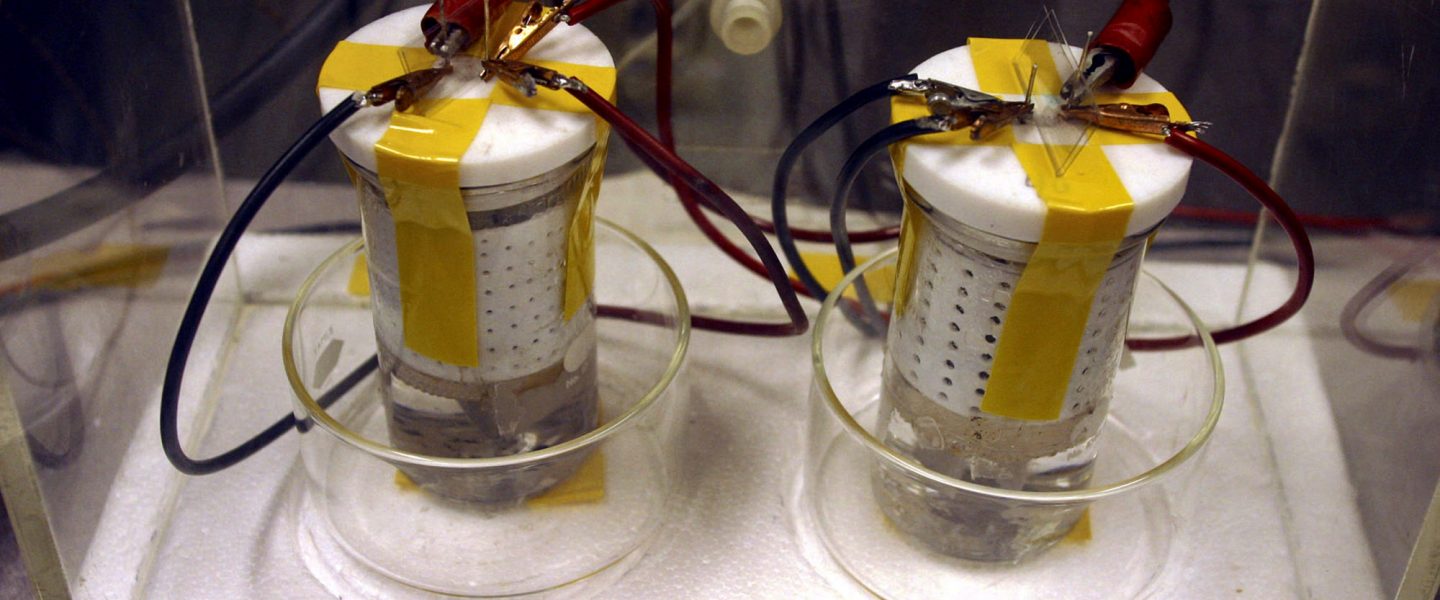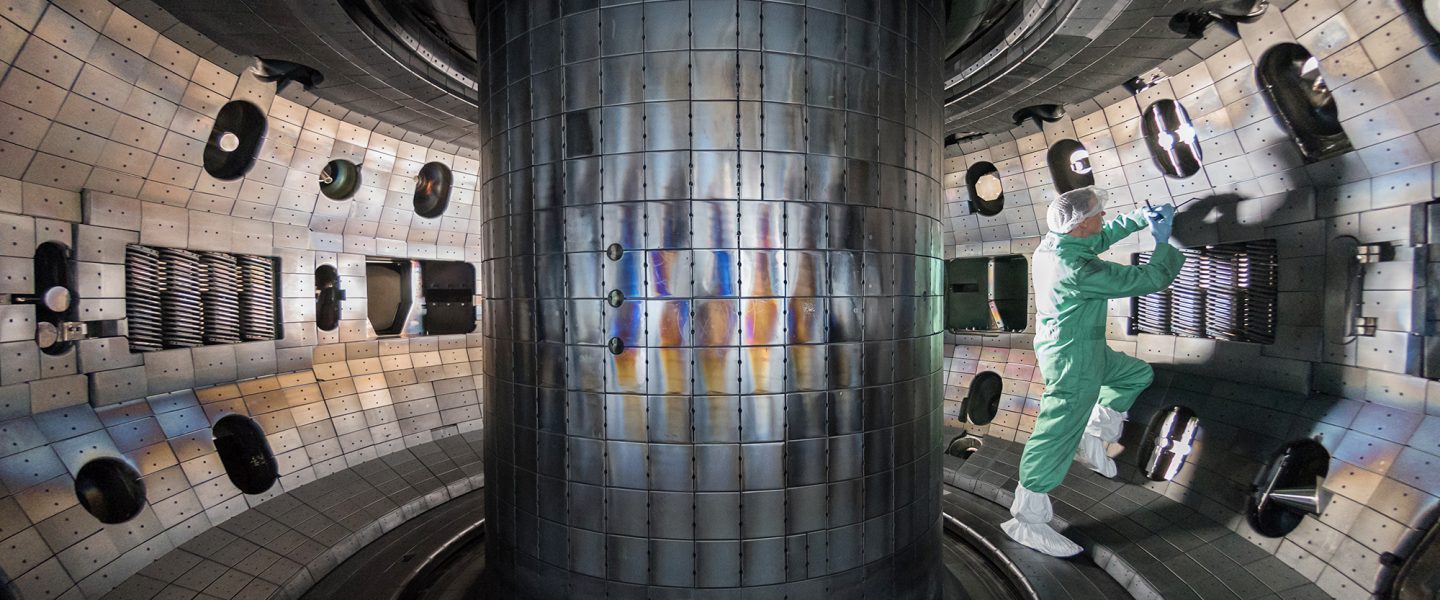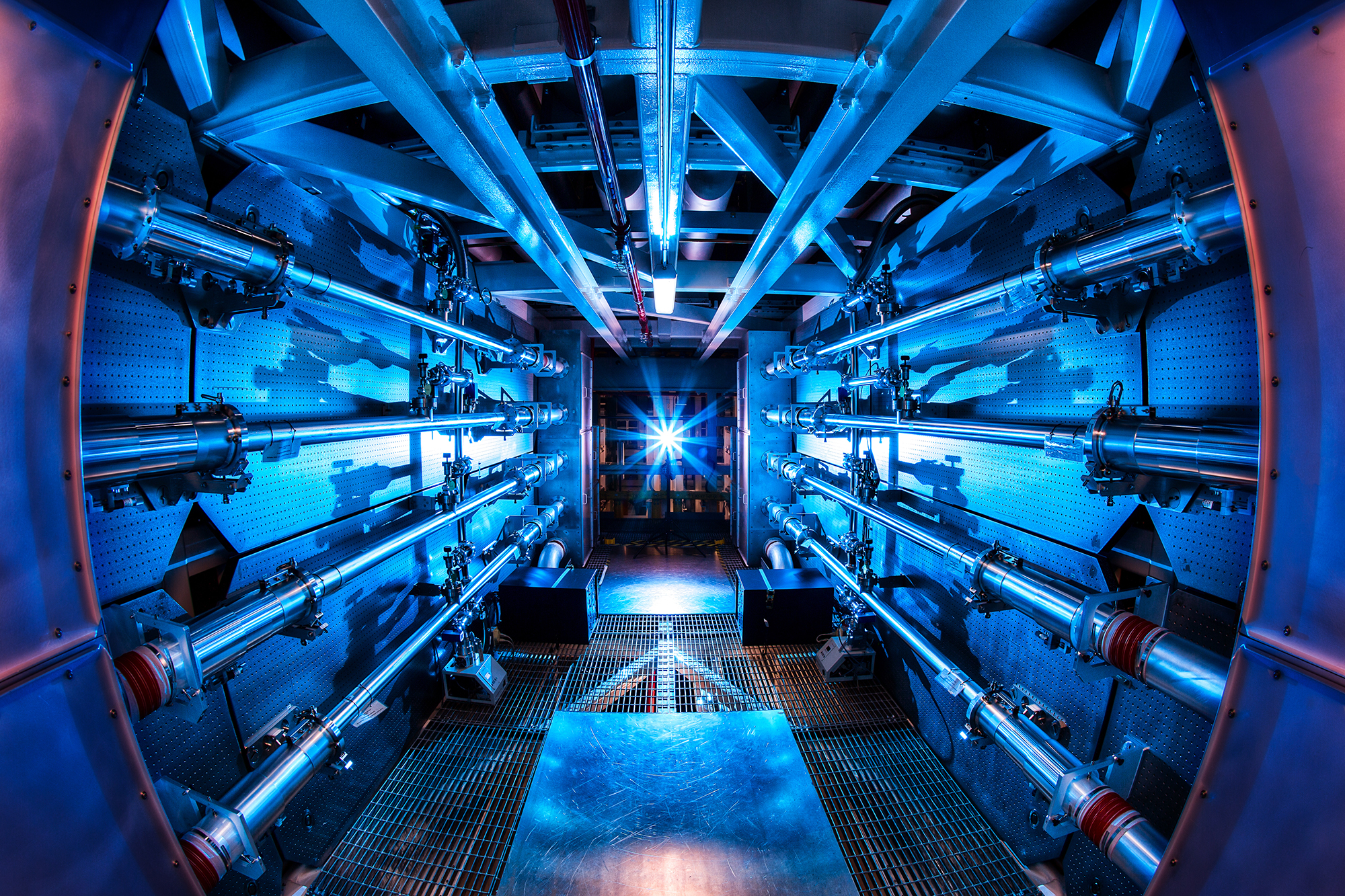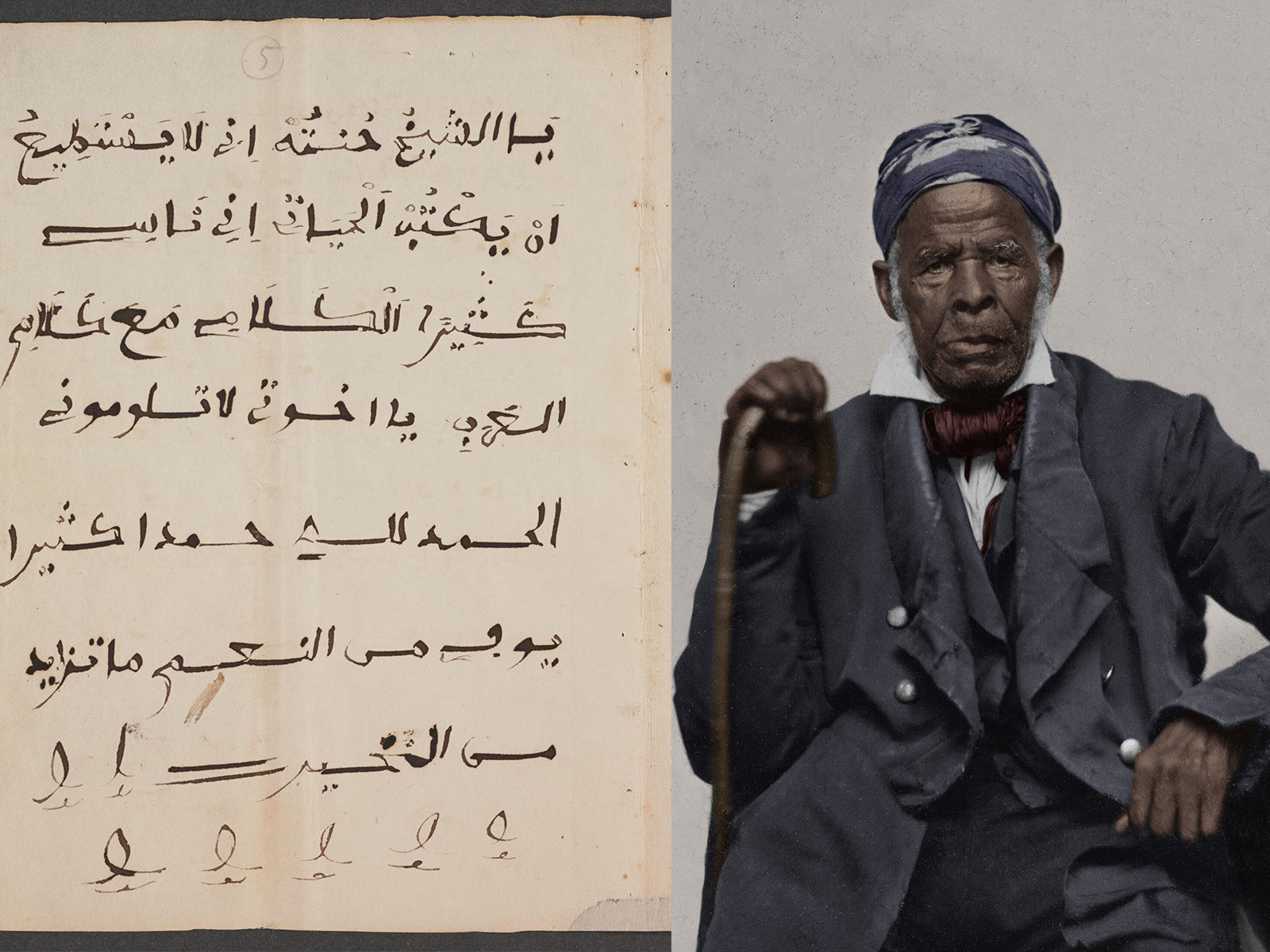SCI FI TECH
Prospective Energy Sources, Part 2: Cold Fusion’s Ice-Cold Reception

One cold weekend in the fall of 1985, professor Stanley Pons of the University of Utah asked one of his undergraduate students to look in on an experiment that he and professor Martin Fleischmann had been conducting in their spare time.
For two years, they had been running electric current through tiny metal cubes in a set-up that was a lot like a battery charger. The metal was an exotic element called palladium, and the electrodes were bathed in “heavy water” — i.e., water made from deuterium, the version of hydrogen that has a neutron along with the proton in the atom’s nucleus.
The experiments were a shot in the dark. Fleischmann had heard rumors from several colleagues that these cells got hotter than they should, so the two had left these cells running continuously for two years, with just enough hint that something unusual was going on to keep them trying different variations, much as Thomas Edison had a little over a century before in his development of a practical incandescent light bulb.
Out of town for the weekend, Pons got a panicked phone call from his student. The glassware was shattered; the lab table had been destroyed; and there was a hole in the concrete floor of the laboratory, where the experiment seemed to have melted through.
Both professors rushed home and met in the lab. They became convinced in that moment that “cold fusion” is real. There is no chemical reaction in the world that could generate that kind of damage from a tiny chip of metal, 1/16 of a cubic inch. It had to be nuclear.
Still, the scientists agreed to make no announcement until they had solid data for the anticipated critics. Pons was chair of the Utah chemistry department, and Fleischmann was a world leader in the little-known field of electrochemistry. Their reputations were solid, but not such as to support an announcement that exploded a major scientific paradigm.

Cold fusion calorimeter NHE diagram. Photo credit: S. Szpak & P. A. Mosier-Boss / Wikimedia
How Unexpected Is Cold Fusion?
Fusion itself was not controversial. It had been recognized since the 1940s, and an international arms race in thermonuclear bombs made it clear that hydrogen could be turned into helium with a monstrous release of energy. But hydrogen nuclei put up quite a resistance if you try to get them close enough together to fuse. Fusing two hydrogen nuclei yields a net output of 24 million volts, but only after you put in 4 million volts as an initial investment, like priming a pump. (See Part 1 of this series.) The only known ways to get hydrogen to fuse were either to ram two nuclei together in a particle accelerator at about 10 percent of the speed of light or, equivalently, to heat the hydrogen to a billion degrees inside a bomb.
Fleischmann and Pons had their epiphany in 1985, but they waited and carefully collected lab data for almost four more years before offering an announcement to the scientific world. They had some sense of the skepticism with which their report would be received, but they were unprepared for the insults and venom that were spewed at them. This announcement would end their careers.
Fusion at room temperature? It does not violate any known laws of physics. For example, it could be understood within Einstein’s framework, E=mc2. But it was highly unexpected, even given what was known about the weirdness of quantum mechanics. It was all about that initial 4 million volt investment. Physicists couldn’t imagine where that energy could come from.
It turns out, at least in theory, that it could come from several places, all related to the still-unfolding weirdness of the quantum world.
Three Weird Things About the Quantum World
ONE — Identical Particles
If two ball bearings come from the same manufacturing process, you expect them to weigh the same, have the same hardness, bounce the same height… but they don’t talk to each other. In quantum mechanics, identical particles are responsive to each other’s presence — and, as it were, converse — even when they are far apart.
This can happen in two opposite ways. Fermions — physicists’ name for the basic subatomic particles including protons, electrons, and neutrons — are “antisocial” in that they will shun each other. This is the deep reason that rocks are hard, and solids and even liquids are practically incompressible. Each electron in “condensed matter” (meaning solid or liquid) marks out its own territory and woe be to any other electron that tries to encroach.
The opposite of a fermion is a boson, and bosons are hypersocial: “Whatever he’s doing, I want to be doing it, too!” And if there’s a party, every boson in town wants to be there.
Lasers are possible because light is made of a type of boson called “photons.” Once you get a lot of photons all marching in step in exactly the same direction, there’s an irresistible pull for the next light particle to join the procession. Another example is superconductivity, in which electrons can flow through a (very cold) wire without any voltage to push them.
If you are interested in a little more detail about bosons and fermions and how quantum physics of identical particles is fundamentally different from an intuitive notion of what it means to be identical, I wrote about this subject last summer.
Yes, electrons are fermions, but sometimes, under rare circumstances and at low temperatures, pairs of electrons can coordinate to act like a single boson. This was not anything that physicists predicted, but superconductivity was observed in laboratories, and three quantum theorists came together to explain it: John Bardeen, Leon Cooper, and John Schrieffer shared a Nobel Prize in 1972.
So how is all this quantum theory relevant to cold fusion? Well, heavy hydrogen turns out to be a boson. Perhaps all the hydrogen nuclei in the cube of palladium were acting in concert and doing something that none of them could do separately. Each separate nucleus was far short of the 4 million volts needed to initiate fusion, but if somehow they could pool their energy, there would be plenty.
TWO — Quantum Tunneling
Think of the way a siphon can suck water up and over an obstacle, so long as the tube has an outlet on the other side of the obstacle that’s lower than the water level in the inlet. Under the right circumstances, a quantum particle can do the same thing — it can “fall” from a high energy state into a low energy state, even when it has to “fall” over the top of a barrier that’s even higher. You can picture an imaginary tunnel going through a mountain to get to a lower place on the far side without having to pass over the top of the mountain.
Relevance: This is exactly what two low-energy hydrogen nuclei do when they fuse to make a helium nucleus of even lower energy. They are “falling” into a lower energy state, cheating because they don’t have the 4 million volt initial investment. Quantum tunneling must be the explanation for how cold fusion happens, and in this sense the problem is solved, but physicists thought they knew how to predict where quantum tunneling happens and what the odds are, and in the situation of hydrogen nuclei inside a palladium crystal, they were pretty sure that quantum tunneling was unlikely. Could they have been wrong? This brings us to the third weirdness.
THREE — Equations That Can’t Be Solved
This is a well-kept secret of quantum mechanics. Physicists don’t like to talk about it.
(Don’t worry, there won’t be a quiz!) Erwin Schrödinger wrote down this famous equation in 1925. He solved it for one electron in the hydrogen atom and it worked perfectly! It was quickly accepted as the fundamental equation of quantum mechanics.
That’s not the secret. The secret is that he couldn’t solve it for two electrons. For just two electrons, the equation became too complicated to solve. In modern times, we solve equations like this with supercomputers that give a very good approximate solution, so we know that Schrödinger’s equation works well for two electrons. For three electrons, however, the equation is too complicated, even for the biggest supercomputer we have. Solving the Schrödinger equation becomes exponentially more difficult with each new particle you add.
That means that everything you’ve ever heard about quantum mechanics in many-particle systems (like atoms larger than helium or any molecules or solids or even gasses) — it’s all based on approximations and heuristics and semiempirical models. Physicists don’t really know for sure how quantum particles behave collectively. So we can be surprised when something like cold fusion comes along, but we can’t be very surprised because we never really solved the full Schrödinger equation in the first place.
Aftermath of the Pons-Fleischmann Announcement
The smartest man I ever knew was Julian Schwinger, who shared a Nobel Prize with Richard Feynman before he taught me quantum mechanics at Harvard. Long after I graduated, Schwinger had moved to California where he learned about the Pons and Fleischmann announcement. Schwinger had as deep a background in quantum theory as anyone alive. From all he knew, he thought about how cold fusion might work and wrote up his theory in 1981.
With all his laurels, Schwinger was accustomed to deference when he submitted papers to the best physics journals but, this time, the Physical Review refused to even consider his theory. Every journal in the country had a policy of refusing papers on cold fusion.
Schwinger was incensed and wrote an angry letter, resigning from the American Physical Society: “The replacement of impartial reviewing by censorship will be the death of science,” he declared. Here is what he wrote about the experience.
MIT was one of the world’s largest recipients of grants to develop hot fusion — a pie totalling hundreds of millions of dollars annually. If fusion turned out to be possible with a simple electrochemical cell costing a few hundred dollars, that funding would evaporate.
To understand why even the towering figure of Julian Schwinger couldn’t get a cold fusion paper published, we have to go back to 1989, and what happened after the announcement of cold fusion. Immediately after the surprise announcement by Pons and Fleischmann in March 1989, the physics community went a little crazy. A plan was hatched to use the prestige of MIT’s scientists to discredit the work. Before they could do any validation experiments, before they could gather a representative response from the scientific community, a statement was prepared and a press conference made headlines.

1989 Boston Herald headline trumpeting demise of cold fusion “breakthrough”
Photo credit: New Energy Times
Pons and Fleischmann were accused not of incompetence but of headline-seeking fraud. “Everything I’ve been able to track down has been bogus, and I think we owe it to the community of scientists to begin to smoke these guys out,” said Ronald R. Parker, director of the Massachusetts Institute of Technology’s Plasma Fusion Center.
Director of the Plasma Fusion Center. Whoa! Can you smell a hint of possible conflict of interest? Not only was Parker steeped in a paradigm that made cold fusion impossible, his position and his salary were at stake. At the time, MIT was one of the world’s largest recipients of grants to develop hot fusion — a pie totalling hundreds of millions of dollars annually. If fusion turned out to be possible with a simple electrochemical cell costing a few hundred dollars, that funding would evaporate.
Over the ensuing months, a dozen laboratories around the world raced to replicate the results of Pons and Fleischmann. Meanwhile, dollar signs were flashing in the administrative eyes of the University of Utah, which claimed patent rights because the research was conducted on its campus by its employees. The university did not want Fleischmann to reveal exact details of their procedure until a patent could be granted. In addition, some of the ambitious scientists who tried to replicate cold fusion thought they might leapfrog ahead of Pons and Fleischmann with clever variations.
Before researchers could put their heads together and compare notes, the hot-minded fusion scientists at MIT prepared a preemptive strike. In an authoritative report to the Department of Energy, submitted in November 1989, they selectively cited all those labs that had failed to replicate the Pons-Fleischmann effect and left out those that reported success, including the US Naval Research Laboratory.
They snookered the news services. I remember reading news accounts of that report at the time and saying a sad goodbye to cold fusion. Like the great majority of physicists, I knew enough to judge that cold fusion was improbable, so it was easy to believe it was just too good to be true.
This is the original 1989 research article by Fleischmann and Pons. Mike McKubre explains why many of the early attempts to replicate it failed — it takes a long time to load the palladium with enough hydrogen to make it work. Over the years, dozens of labs around the globe have seen bursts of energy in deuterium experiments, and the current challenge is finding ways to turn the reaction on and off reliably.
For readers who are technically inclined, Steven Krivit wrote a good review of the state of the art a decade ago, and a bibliography is available from New Energy Times. I personally witnessed cold fusion demos and inspected the data at Stanford Research Institute (Mike McKubre), MIT (Peter Hagelstein), and the University of Missouri (Graham Hubler). Focardi et al first reported success using nickel instead of palladium in 1998. Here is a 2004 update on what Fleischmann was able to accomplish. This is a 2009 assessment of the technology from the US Defense Intelligence Agency.
Eugene Mallove, MIT alumnus and editor of Infinite Energy magazine, wrote these words in 2003 before being murdered in 2004:
In fact, the story of cold fusion’s reception at MIT is a story of egregious scientific fraud and the coverup of scientific fraud and other misconduct — not by Fleischmann and Pons, as is occasionally alleged, but by researchers who in 1989 aimed to dismiss cold fusion as quickly as possible and who have received hundreds of millions of DOE research dollars since then for their hot fusion research.
We know for a fact, with journalistic certainty, that Mallove’s killing was not related to his scientific work. But Wade Frazier recounts bribes, threats, and arrests of others who have tried to commercialize breakout energy technologies. It is fair, I think, to say that various powers have brought their own interests and agendas to how we power our world, and much has transpired behind the scenes and the headlines in this field.
Coming soon in Part 3: Powerful interests are hellbent on keeping cold fusion technology from the public. Are there other reasons besides the economic conflicts?
Josh Mitteldorf holds a Ph.D. in theoretical physics from the University of Pennsylvania.
Prospective Energy Sources: Fusion Is Hot! (and Cold!)

I’m sorry to disappoint you. This article won’t help you discover new ways to use delicious French sauces in a Chinese stir-fry. I’m going to talk about physics — in particular, the energy source for the sun and the hydrogen bomb. This article will be an introduction to fusion energy. Part 2 next week will be a status report on cold fusion — a “dangerous” idea since 1989.
An atom has two parts. The nucleus is a small central core with neutrons and protons stuck together. The electrons whiz around in a much, much larger cloud, moving so fast that quantum uncertainty says you can’t even tell where they are or which electron is which.
Physicists like to measure energy in volts — the same volts with which we rate batteries. The energy in the electrons is typically a few volts. It’s no coincidence that batteries are typically a few volts, because batteries work by moving electrons from one atom to another.
(I am using the word “volts” throughout this article as a measure of energy. Technically, voltage measures the energy in each electron, and physicists use the word “electron-volt,” abbreviated eV, as a unit of energy. One eV is the amount of energy carried by each electron in a one-volt battery. The energy of electrons in molecules is measured in eV, and nuclear energies are measured in MeV = million electron volts. From here on, I’ll just say “volts.”)
All of chemistry is based on the exchange of electrons or the sharing of electrons among atoms. A flame or a typical flashlight battery or salt dissolving in water or photosynthesis – which plants use to turn H2O and CO2 into biomolecules — all these are examples of chemistry, and they are all working with energies of two volts or less.
The energy in the nucleus is measured in millions of volts. The nucleus is held together by a force that some unimaginative physicist named the “strong force” — and that is the name by which physicists still refer to it today. You may wonder why all those protons would stick tight in the nucleus since they each have a positive charge, and positive charges are supposed to mutually repel one another. The answer is that there is a balance between the electrical force that tends to tear the nucleus apart and the strong force that tends to hold it together.
This balance between electric repulsion and “strong” attraction is different for different kinds of atoms. Remember, we’re dealing with millions of volts — millions of times the energy of fire. The uranium nucleus is the largest found in nature (92 protons), and if you can split a uranium atom into two smaller nuclei, the process releases 200 million volts. This process is called fission. In August of 1945, millions of innocent citizens in the cities of Hiroshima and Nagasaki had a direct experience of 200 million volts in action.
Hydrogen is the smallest nucleus found in nature, with just one proton. Two hydrogen nuclei can be joined together to make helium (two protons), and in the process, 24 million volts are released. This is called fusion. (Yes, small nuclei want to come together to release energy, and large nuclei want to break apart to release energy. The happy midpoint is iron, whose 26-proton nucleus doesn’t want either to split apart or to join together. Boring!)
Hydrogen undergoes fusion inside a thermonuclear bomb, aka a hydrogen bomb. The process also happens at the center of the sun, providing the energy to keep the sun shining for billions of years.
The protons in hydrogen are positively charged, so they don’t spontaneously get close enough to stick together. The positive charges make it difficult to get two hydrogen nuclei close enough to fuse into helium. (Ordinary hydrogen nuclei, having only a single proton and no neutrons, are unique among the elements in having no strong force. Bombs and fusion reactors use heavy hydrogen, with extra neutrons that make it easier for two hydrogens to stick together.) The amount of energy required to push the nuclei together is about 4 million volts. So, 4 million volts in, 28 million volts out — a big net plus. But where can we find the 4-million-volt primer?
The center of the sun is hot enough that hydrogen atoms can get the energy needed to fuse into helium, but not all at the same time, so that the process happens slowly and the sun lasts billions of years. In a thermonuclear bomb, the temperature gets even hotter than the sun, and the fusion is instantaneous. There is a shell of uranium with hydrogen on the inside. When the uranium explodes via fission, it heats and compresses the hydrogen, and hydrogen fusion produces a far bigger explosion than from uranium alone. (The 20 million volts from hydrogen may seem much smaller than 200 million volts from uranium, but hydrogen is much lighter and cheaper than uranium, and a bomb of equivalent weight and price can contain much more of it.)
Fission doesn’t have to be inside a bomb; controlled fission is what drives a nuclear power plant. Ever since the concept of hydrogen fusion was proven (in bombs), there has been the dream of controlling fusion, a little bit at a time, to release energy for an electric power plant. The promise is enticing.
- Twenty-four million volts are released every time you get two hydrogen nuclei to join together
- There is much less dangerous radioactivity than in a nuclear power plant
- The process produces no radioactive waste
- Hydrogen is abundant, unlike uranium, which is quite rare
But getting the two hydrogens close enough to fuse is a daunting prospect. Nuclear physicists and engineers have been working on it for almost 70 years. Many tens of billions of dollars have been granted by the Department of Energy and its predecessors since the 1950s, and the project is still far from creating a commercially viable fusion machine. In my opinion, the funding is kept alive by the lobbying power of established scientists, which is strong enough to get their contracts renewed year after year.
There are two main strategies used to try to make fusion happen. Both involve enormously hot temperatures.
Strategy number one is the tokamak, in which an electric current is used to heat the hydrogen to millions of degrees.
It’s not hard to send an electric current through hydrogen gas when the hydrogen is in its plasma state, with electrons separated from the nucleus at high temperatures. The problem is that once the plasma reaches a few thousand degrees, every known material will melt, so when hydrogen is anywhere near hot enough for fusion, you can’t keep it in any kind of container.
The classic way around this is to use a powerful magnetic field to push the hydrogen away from the walls of a donut-shaped “bottle.” The electric current makes the hydrogen magnetic, and the magnetic field outside the bottle is shaped in such a way as to push on the hydrogen from all sides.

Basic tokamak components include the toroidal field coils (in blue), the central solenoid (in green),
and poloidal field coils (in gray). The total magnetic field (in black) around the torus confines
the path of travel of the charged plasma particles. Photo credit: Courtesy of EUROfusion via DoE
But the electricity flowing through the hydrogen is like lightning. The path taken by the electric current is constantly shifting because wherever the electricity goes, it causes a little explosion that disrupts the flow of current, which has to find a new path. Since there’s no controlling the path the electricity will take, the magnetic field has to adjust its shape a million times per second in order to hold the hydrogen together. This is an engineering challenge that has stymied the tokamak project for decades.
Strategy number two is called “inertial confinement.” The plan is to create a little pellet of solid hydrogen and zap it with lasers converging from all directions. The pellet is actually two types of “heavy” hydrogen — rare isotopes with a neutron or two added to their nuclei – held in a crystal and frozen to a few degrees above absolute zero.
Ordinarily, if you started to heat the solid hydrogen with lasers, the pellet would explode — from a rapid increase in gas pressure — before the hydrogen gets hot enough to fuse. The trick is to use lasers so powerful that the requisite heat is deposited in billionths of a second, causing the pellet to get hot enough to fuse before it has a chance to fly apart.
The lasers required are each as long as a football field, so big that it takes many billionths of a second just for light to get from one end of a laser to the other. Focussing all that energy from a couple hundred lasers on a pea-sized target at exactly the same moment is an engineering feat, to say the least. Nevertheless, the inertial confinement method has now leapfrogged ahead of the tokamak, after a much later start.

A color-enhanced image of the inside of a National Ignition Facility preamplifier support structure.
Credit: Damien Jemison. Photo credit: Damien Jemison / Lawrence Livermore National Laboratory
Last month, the Lawrence Livermore National Laboratory announced that they had succeeded for the first time in getting more fusion energy out of the system than the laser energy they had put in. “Breakthrough!” trumpeted the headline. Which it was.
But the announcement was based on selective bookkeeping.
The Livermore researchers counted the “energy in” from the 192 lasers they used, but they didn’t headline the fact that it took a hundred times that much electrical energy to generate those powerful and tightly focussed laser beams. They also counted all the heat produced by the fusing hydrogen as “energy out” without accounting for the fact that you would have to boil water with that heat and use steam to turn a turbine to drive an electric generator, a process that is less than 40 percent efficient overall. And they didn’t count the energy (or expense) of preparing the pellet with those special kinds of heavy hydrogen that fuse easily.
When all the energy inputs needed to achieve this fusion “breakthrough” are toted up, the process actually “cost” about a thousand times more energy than it generated.
In other words, while the Livermore process is undoubtedly impressive as a feat of engineering, scientists will have to make the process a thousand times more efficient before it can give rise to a commercially viable power plant. The progress announced will be just sufficient to keep the research grants coming in, but I think it highly unlikely that hot fusion will become a practical energy source in the time left before something better becomes available. Does Congress have enough collective scientific understanding to judge which are the best billion-dollar bets on climate-friendly future energy technology?
Next week: Cold fusion is not vichyssoise with sushi, but it may be a suppressed technology capable of transforming our civilization.
——————
Josh Mitteldorf’s PhD is in theoretical physics, but his current research is in the evolutionary biology of aging. His book, with Dorion Sagan, tells the surprising story of why we get old and what we can do about it. His writing is featured at ScienceBlog and his own Substack page. Check out his poetry.




![Postcard from Eritrea. Asmara - Festa del Mascal. Firenze: Ballerini and Fratini, [date of publication not identified]. Image courtesy of Library of Congress](https://religionnews.com/wp-content/uploads/2023/02/webRNS-Library-Congress-Grant1-807x563.jpg)




